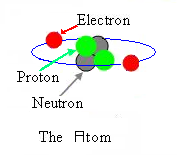
Introduction
Chapter 1 - Electricity
Chapter 1.2 - The Numbers
Chapter 2 – Sharing and Bonding
Chapter 3 - Voltage
Chapter 3.2 – Voltage Static
Chapter 3.3 - Batteries
Chapter 3.4 – Solar - Others
Chapter 4 - Resistance
Chapter 4.2 – Parallel Resistance
Chapter 4.3 – Voltage Dividers
Chapter 5 - Semiconductor
Chapter 5.2 - PNP NPN Junctions
Chapter 6 – AC and Hertz
Chapter 7 - Magnetism
Chapter 7.2 - Inductors
Chapter 8 - Capacitor
Chapter 9 - IC's and Amplifier
Chapter 10 - 555 Timer
Chapter 11 - Logic
Chapter 12 - Power Supply
|
|
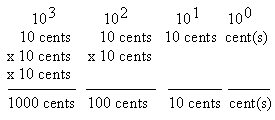 Lets start by thinking of the POWER of MONEY, which is based on the base-10 numbering
system. Looking at the illustration to the right, the top row displays the BASE and
something called an EXPONENT. This row had 10 as the base and the exponents 3, 2,
1, and 0. In simple terms, if the exponent is the number 0 you have what you
have in the number set. In base-10 that is the range of numbers 0 through 9. Look at
the far right-hand side of this illustration and note the 10 raised to the power of 0.
This column with exponent 0 represents the numbers from 0 through 9 (cents in this
example). The two columns with exponents 1 and 0 can represent any two-digit
combinations within the number set. For my money chart that would be 0 to 99 cents.
Column with exponents 2, 1 and 0 represent any three-digit number combination
within the number set.
Lets start by thinking of the POWER of MONEY, which is based on the base-10 numbering
system. Looking at the illustration to the right, the top row displays the BASE and
something called an EXPONENT. This row had 10 as the base and the exponents 3, 2,
1, and 0. In simple terms, if the exponent is the number 0 you have what you
have in the number set. In base-10 that is the range of numbers 0 through 9. Look at
the far right-hand side of this illustration and note the 10 raised to the power of 0.
This column with exponent 0 represents the numbers from 0 through 9 (cents in this
example). The two columns with exponents 1 and 0 can represent any two-digit
combinations within the number set. For my money chart that would be 0 to 99 cents.
Column with exponents 2, 1 and 0 represent any three-digit number combination
within the number set. OK, time to dig in. Lets start by adding the number 123 to the
number 345. In reality I am adding 100 plus 20 plus 3 plus
300 plus 40 plus 5. In breaking this process apart, we can look at the parts, in order.
OK, time to dig in. Lets start by adding the number 123 to the
number 345. In reality I am adding 100 plus 20 plus 3 plus
300 plus 40 plus 5. In breaking this process apart, we can look at the parts, in order.
 We also know something about the word carry. To see how this works,
replace the number 123 with the number 167 in this simple equation.
We also know something about the word carry. To see how this works,
replace the number 123 with the number 167 in this simple equation.
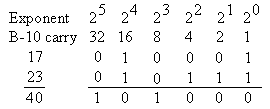 All is good so far. In this illustration we will step through the
same process as we did with the base-10 system. Here we will add
2 bass-10 numbers, namely 17 and 23 (base-10). We will look at
both the base-10 and base-2 math.
All is good so far. In this illustration we will step through the
same process as we did with the base-10 system. Here we will add
2 bass-10 numbers, namely 17 and 23 (base-10). We will look at
both the base-10 and base-2 math.
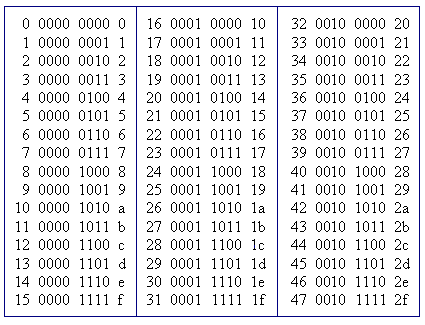
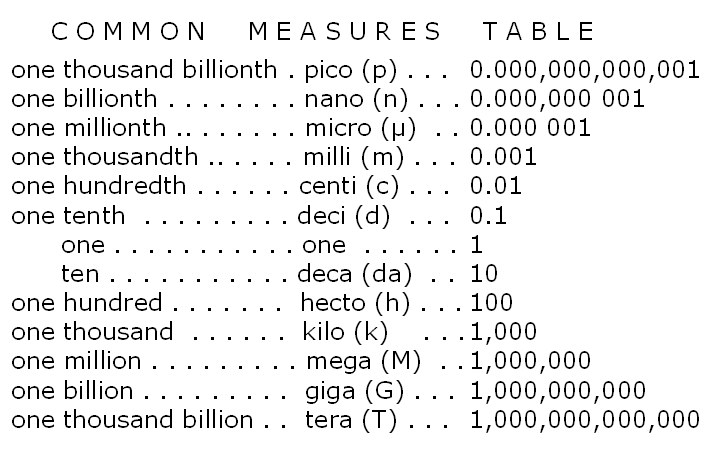 One more bit of useful information is using a conversion table. It is common to
use letters to represent number. At the center of the table is the 1's place.
To convert form 100 pennies to 1 dollars divide by 100. To convert a kilometer
to meters multiply by 1000.
A MICRO-something is very small at one-millionth of the something.
If your camera has a 5.1 megapixel rating you will have 5.1 million pixels (5100000 pixels) of picture resolution.
A tera-byte of data is one-thousand-billion bytes of data. That is a lot.
One more bit of useful information is using a conversion table. It is common to
use letters to represent number. At the center of the table is the 1's place.
To convert form 100 pennies to 1 dollars divide by 100. To convert a kilometer
to meters multiply by 1000.
A MICRO-something is very small at one-millionth of the something.
If your camera has a 5.1 megapixel rating you will have 5.1 million pixels (5100000 pixels) of picture resolution.
A tera-byte of data is one-thousand-billion bytes of data. That is a lot.